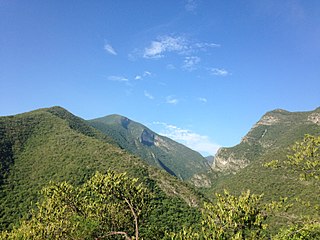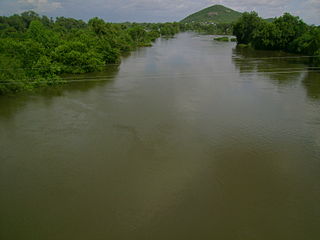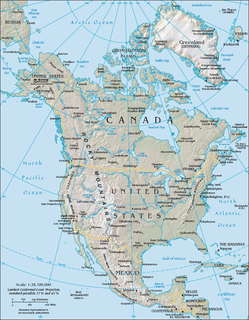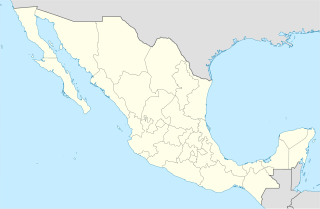
Sinaloa, officially the Estado Libre y Soberano de Sinaloa, is one of the 31 states which, along with Mexico City, comprise the Federal Entities of Mexico. It is divided into 18 municipalities and its capital city is Culiacán Rosales.

Culiacán, officially Culiacán Rosales, is a city in northwestern Mexico that is the capital of and the largest city in Sinaloa and in the Culiacán Municipality. It was founded on September 29, 1531 by the Spanish conquerors Lázaro de Cebreros and Nuño Beltrán de Guzmán under the name of Villa de San Miguel, which referred to its patron saint, Michael the Archangel.

The Sierra Madre Occidental is a major mountain range system of the North American Cordillera, that runs northwest–southeast through northwestern and western Mexico, and along the Gulf of California. The Sierra Madre is part of the American Cordillera, a chain of mountain ranges (cordillera) that consists of an almost continuous sequence of mountain ranges that form the western 'sounds' of North America, Central America, South America and West Antarctica.

The Sierra Madre Oriental is a mountain range in northeastern Mexico. The Sierra Madre Oriental is part of the American Cordillera, a chain of mountain ranges (cordillera) that consists of an almost continuous sequence of mountain ranges that form the western "backbone" of North America, Central America, South America, and Antarctica.

The Fuerte River is a river in the state of Sinaloa, in northwestern Mexico. It flows from headwaters in the Sierra Madre Occidental to the Pacific Ocean in the Gulf of California.

The Sierra Madre Occidental pine–oak forests are a Temperate broadleaf and mixed forests ecoregion of the Sierra Madre Occidental range from the southwest USA region to the western part of Mexico. They are home to a large number of endemic plants and important habitat for wildlife.

The North American Cordillera. sometimes also called the Western Cordillera of North America, the Western Cordillera or the Pacific Cordillera, is the North American portion of the American Cordillera, the mountain chain system (cordillera) along the western coast of the Americas. The North American Cordillera covers an extensive area of mountain ranges, intermontane basins and plateaus in Western/Northwestern Canada, Western United States and Mexico, including much of the territory west of the Great Plains.

The Tamazula River is a river in the state of Sinaloa, Mexico, originating in the Sierra Madre Occidental mountains, flowing westward towards the Pacific Ocean. The Tamazula receives the Humaya River in the city of Culiacán to form the Culiacán River.
The Humaya River is a river in the state of Sinaloa, Mexico, that connects to the Tamazula River in the city of Culiacán to form the Culiacán River. The source of the river is the Sierra Madre Occidental mountains. The water flows from the north of the city. The water then flows to the Pacific Ocean.

Lake Arareco is a lake high in the Sierra Madre Occidental range, within Chihuahua state in northwestern Mexico.

Copala, formerly known as San José de Copala, is a four-century-old silver-mining town in the Mexican state of Sinaloa. The town is in the municipality of Concordia.
The Mexican golden trout is a species of fish in the family Salmonidae. The species is endemic to high-elevation headwaters of the Fuerte River, Sinaloa River, and Culiacán River drainages in the Sierra Madre Occidental in Mexico.

Tamazula de Victoria is a small town and seat of the municipality of Tamazula in the Mexican state of Durango, near the Sierra Madre Occidental mountains. The town is located about 1.5 hours east of Culiacán, Sinaloa. General Guadalupe Victoria, the first president of Mexico, was born there, hence the name. Its official name is Tamazula de Victoria. As of 2010, the town had a population of 2,337 The Tamazula River runs directly north of the town.

The Aguanaval River is a river located in northeastern Mexico.

The Rio San Bernardino, or San Bernardino River, begins in extreme southeastern Cochise County, Arizona, and is a tributary of the Bavispe River, in Sonora, Mexico.
Federal Highway 24 is a free part of the federal highways corridors. Fed. 24 is intended to cross the Sierra Madre Occidental from the area of Hidalgo del Parral, Chihuahua, on the east, to the area of Culiacán, Sinaloa, on the west. A limited central section of about 40 to 50 km is not yet completed or graded. This section lies between the villages of Los Frailes, Durango, on the east, and Soyatita, Sinaloa, on the west. Travel is possible through this area, where the road is not yet completed, on unimproved roads using high clearance two-wheel drive vehicles. The two unconnected segments that extend through Los Frailes and Soyatita are graded, but each segment is unpaved for about the last 75 km. The central gap in the highway is in the rugged mountains of the Sierra Madre Occidental. This uncompleted and unpaved portion of the road is not well signed, there are many intersections with other unimproved roads, and it is easy to get lost off the intended route of the highway. As noted later, getting lost may not be a safe proposition. Further, the unfinished segment on the west is at about 820 meters elevation at Soyatita. Just outside Los Frailes, the road coming from the east is at 2,750 meters elevation. The traveler crossing this gap will have to negotiate this dramatic change in elevation traveling a good deal of the way on unimproved dirt roads. Travel times in this central section can be quite slow.

The San Pedro Mezquital River is a river of Nayarit, Mexico.
Federal Highway 36 is a free part of the federal highways corridors of Mexico. The highway construction is entirely within the state of Durango. The official start of the highway indicates it begins in the city of Topia then runs eastward to the town of Los Herrera. However, the paved and graded portion of the road does not go to Topia. Along the graded and paved road at a point about 96 km (60 mi) from Santiago de Papasquiaro a narrow and ungraded road leads off of Fed. 36 and extends 28 km (17 mi) to Topia, Durango. The road from Fed. 36 to Topia is a narrow dirt road. The paved and graded road system continues past that intersection and has been extended year by year in a westward direction to the crest of the Sierra Madre Occidental and down the western slope of the Sierras, following the drainage of the Topia River, past Canales, Durango and then on to the end of construction in a dead end about 24 km. beyond Canales at the remote village of La Angostura. This village just happens to be the home of Ines Coronel Barreras, a cattle rancher and Sinaloa drug lord, who is the father of Emma Coronel Aispuro, the Mexican beauty queen and wife of the internationally notorious drug lord Joaquin "El Chapo" Guzman, currently indicted and in jail in the United States for drug related crimes. This terminus of the graded and paved road is only 32 km (20 mi) by direct line from Tamazula de Victoria, Durango. It is unknown whether there will be further road construction beyond La Angostura to Tamazula de Victoria in the coming years though that would be feasible from an engineering standpoint. Until the completion of the highway construction an alternative route which is ungraded branches off the paved road on the crest of the mountains and continues on to highways in the state of Sinaloa. Those routes are all noted below.
Mexican native trout —Mexican rainbow trout, sometimes Baja rainbow trout and Mexican golden trout occur in the Pacific Ocean tributaries of the Baja California peninsula and in the Sierra Madre Occidental of northwestern Mexico as far south as Victoria de Durango in the state of Durango. Many forms of the Mexican rainbow trout, subspecies of the rainbow trout, have been described. The Mexican golden trout is a recognized species.
Rio Cuchujaqui, Arroyo Cuchujaqui or Arroyo de Alamos, is a tributary river of the Fuerte River, in the Álamos Municipality of Sonora and in El Fuerte Municipality, Sinaloa, Mexico. It has its source in the Sierra de Álamos a range in the Sierra Madre Occidental in the Álamos Municipality of Sonora. Its mouth is at its confluence with the Fuerte River, just below Tehueco in Sinaloa. Its course is interrupted in Sinaloa by the Josefa Ortiz de Domínguez dam and its reservoir at 26°25′50″N108°42′24″W built between 1964 and 1970.













